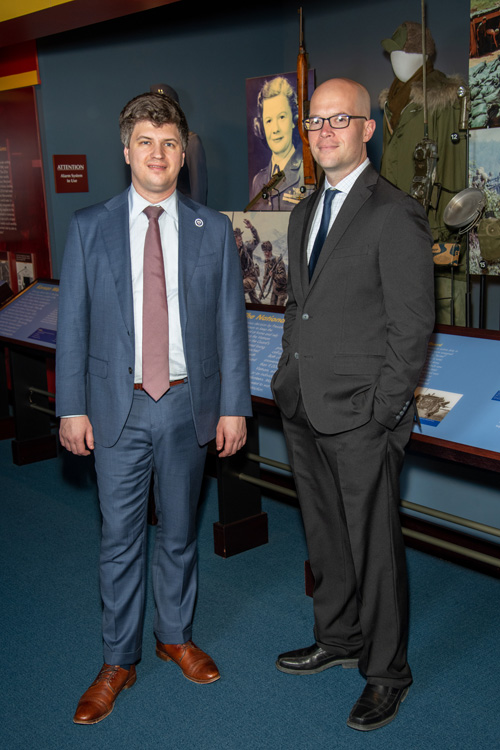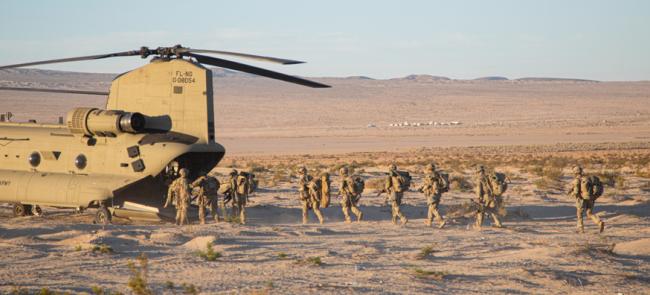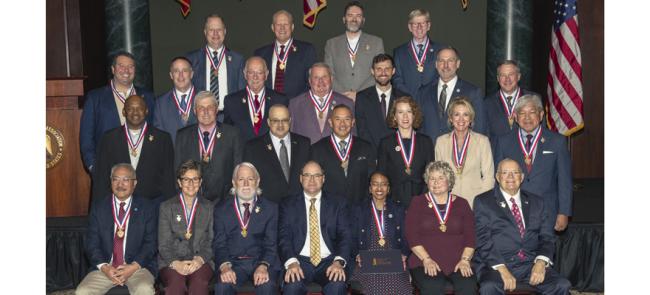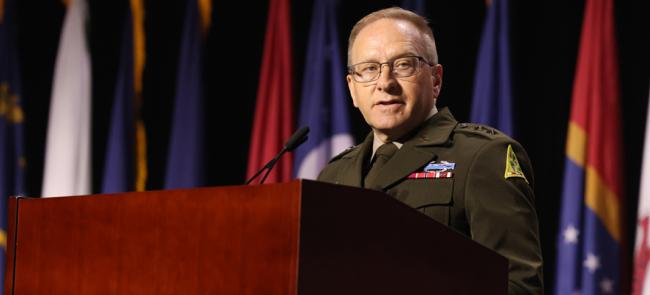Show and Tell
The host of the National Guard Educational Foundation’s popular Minuteman Minute series on YouTube says he has enough content for many years of monthly videos.
William Roulett’s confidence is a function of numbers. Each 60-second installment focuses on an artifact from the National Guard Memorial Museum, which has a collection of some 2,500 objects from the Guard’s nearly 400 years of history.
Recent episodes have featured a 1775 Rhode Island militia mobilization order issued in the days after the battles of Lexington and Concord and the pistol that Colorado Guard Lt. Col. Felix Sparks used during the liberation of the Dachau concentration camp during World War II.
“Each video is a peek into the museum,” says Roulett, the NGEF deputy director and the curator of the only museum dedicated to the Guard at the national level.
The facility is located on the first floor of the National Guard Memorial, the NGAUS and NGEF headquarters in Washington, D.C. It includes six galleries, each covering a different time period, spread over 5,600 square feet of space.
Roulett, who has a master’s degree in history from Rutgers University, has been on the job since January 2022. He previously worked at the Fire Museum of Maryland. To produce Minuteman Minute, he also draws on his training as an Army broadcast journalist.
“It’s been fun to research and to write the scripts,” he says. “For me personally, it’s been a way to become more intimately familiar with specific objects in the collection. So many have an interesting backstory that deserves to be told.”
Each video is a peek into the museum.
—Will Roulett, the deputy director of the National Guard Educational Foundation
The NGEF also operates a research library of nearly 4,000 bound titles along with a large archive of state records and reports and NGAUS documents and photos dating back to the association’s creation in 1878.
The foundation also maintains a website at www.ngef.org featuring a virtual tour of the museum and a frequently updated blog with stories on important events and figures in Guard history.
Among the recent posts is a story about Maj. Gen. Henry V. Graham, the adjutant general of Alabama from 1959 to 1963. President John F. Kennedy federalized Graham on June 11, 1963, to order his state commander in chief, Gov. George Wallace, to stop blocking two Black students from enrolling at the University of Alabama.
The foundation also administers two one-of-a-kind Guard scholarship programs. The Leonardo DRS Scholarship helps the children of Guardsmen killed in the war on terror, while The Van Hipp Heroes Scholarship Fund awards scholarships to Guardsmen wounded in the conflict.
Private donations make all of the NGEF’s work possible.
Roulett spent much of his first few months on the job working with Kevin Brown, the museum specialist and archivist, to reopen the museum after it was closed for nearly two years due to the COVID-19 pandemic.
On most days, the traffic is light, Roulett says. The exception is when planned groups arrive, including Guard delegations touring the nation’s capital.
Some visitors walk through the museum in 30 minutes, he adds, but others linger much longer over the exhibits, which include interactive displays and a memorial wall of the names of the 800 Guardsmen killed in action since Sept. 11, 2001.
Roulett juggles his responsibilities with his duties as a sergeant in the Army Reserve’s 52nd Military History Detachment at Fort Indiantown Gap, Pennsylvania.
With an assigned strength of just three soldiers, MHDs are the smallest units in the Army. They collect documents, artifacts and photographs to help officials write accurate historical accounts of operations. There are 35 such units in the Army; all but one are in the Guard and Reserve.
Roulett deployed with his unit to the Middle East in December 2020 to help document Operation Freedom’s Sentinel. He conducted oral history interviews, collected electronic documents and helped write about the retrograde of U.S. forces in Afghanistan. The materials all went to U.S. Army Center of Military History at Fort McNair in Washington, D.C.
Roulett’s military and museum experiences sometimes intersect.

The Pennsylvania National Guard Military Museum in Fort Indiantown Gap recently reached out to his detachment to help with the collection of materials on the Pennsylvania Guard’s response to the COVID-19 pandemic and the civil unrest following the death of George Floyd.
Roulett says his unit interviewed Pennsylvania Guardsmen about their experiences. He said he learned a lot about how the Guard deployed and met the challenges of simultaneous responses.
“It was good for us to gain more practical experience in our mission in our job,” he says, “and it’s good for the Pennsylvania National Guard to capture that while it’s still fresh in the memories of those people.”
Brown has a different background. He holds a bachelor’s degree in history from George Mason University in Northern Virginia and a master’s degree in international history from the London School of Economics.
After college, he worked for political campaigns, including former President Donald Trump’s reelection effort in 2020. He started at NGAUS as a legislative analyst in 2021.
“I originally worked in opposition research [in politics],” he said. “That involves going into the archives. I’ll see how archives are arranged, going out to the field to dig out documents. So, I had a lot of experience with that and how to synthesize documents, and how to relay that information to end users.”
Brown says he has enjoyed helping researchers and the public find the Guard material that they’re looking for in the archives. He also helps with genealogy requests.
“We get a lot of requests that vary from anywhere from PhD students to people trying to find an ancestor that served in a Union regiment during the Civil War,” he says.
“We had a guy from the French Defense Ministry doing a project on the National Guard,” Brown adds. “He came in and he basically looked at National Guard history and how it can be a potential concept for the reserve forces in the French military and for European defense in general.”
Brown said he wants to continue gathering materials this year for the archive, including items from the pandemic response.
Roulett’s 2023 plans are more ambitious: He wants to increase museum traffic.
“I want to communicate with groups and schools and teachers and tourism groups that might bring people into the museum,” he explains. “I also want to collaborate with other National Guard museums, help lift each other up and share resources and expertise. We all have the same mission: Tell the Guard story.”
The author can be reached at [email protected].

The Minuteman Minute series of short National Guard history videos is available in the NGAUS Video Library on the NGAUS website here or on the NGAUS YouTube Channel at www.youtube.com/@NGAUS1878/videos.



